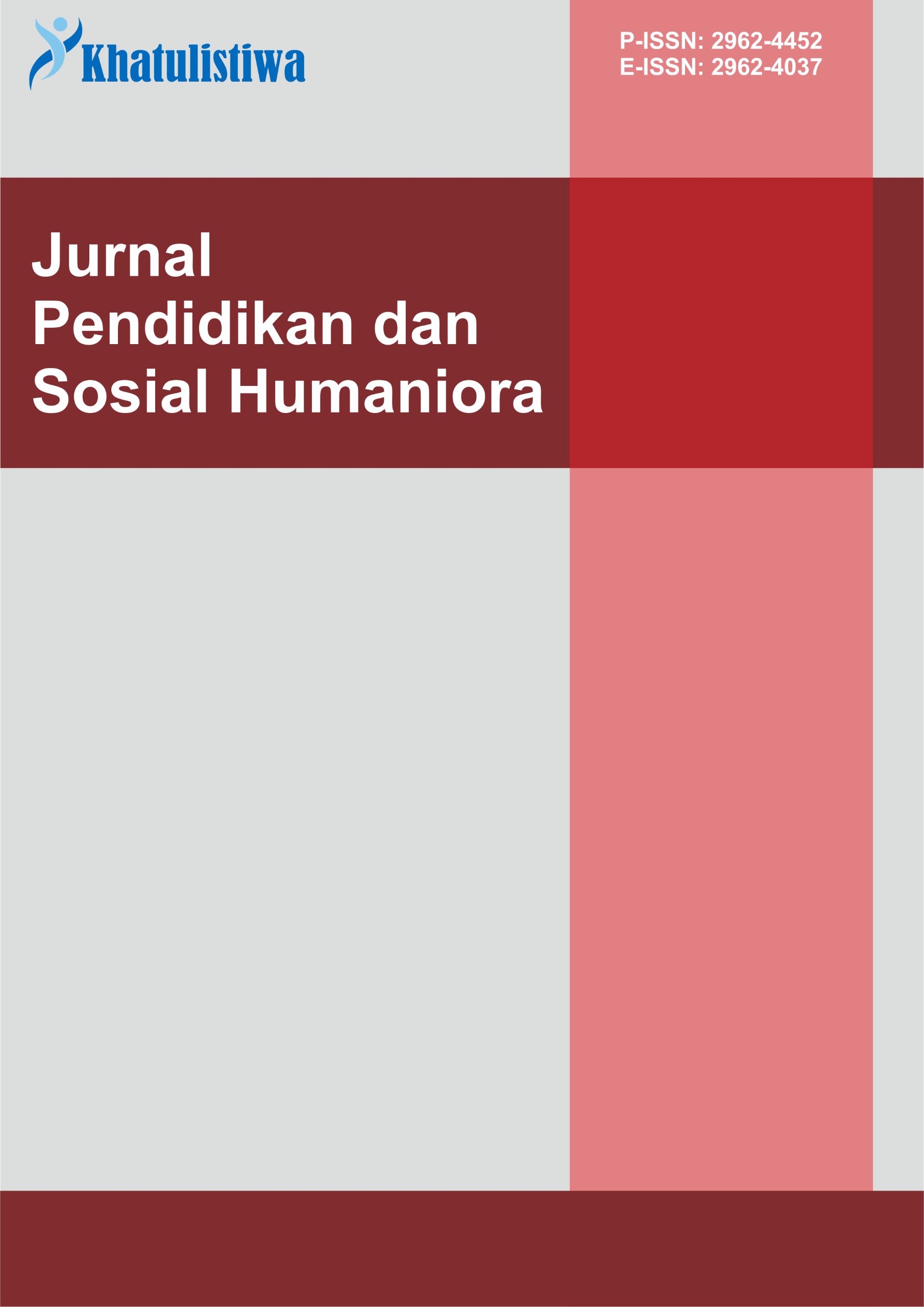Dampak Gamifikasi Blooket terhadap Motivasi dan Pembelajaran Ekonomi
DOI:
https://doi.org/10.55606/khatulistiwa.v5i3.7354Keywords:
Blooket, Economics, Gamification, Learning Motivation, Learning OutcomesAbstract
Student motivation is an important factor that influences student engagement and academic achievement. Although many studies have examined learning motivation in classroom settings with non-interactive presentation media, limited research has explored how gamification affects motivation and learning outcomes in economics education. This study investigates the impact of using Blooket—a game-based learning platform—on students’ motivation and academic performance in economics classes during the 2024/2025 academic year. The study aims to: (i) evaluate the impact of Blooket on students’ learning motivation, (ii) assess the impact of Blooket on students’ learning outcomes. Data were collected through questionnaires and tests involving 40 high school students divided into experimental and control groups. The findings revealed that students taught using Blooket demonstrated significantly higher motivation and better learning outcomes compared to those taught using traditional methods. This study highlights the impact of the gamification medium 'Blooket' in fostering a more engaging and motivating learning environment, offering practical insights for educators seeking to enhance student participation and performance through digital tools.
References
Adiningsih, R. K., & Sulur. (2024). Efektivitas penerapan permainan Blooket sebagai media digital terhadap pembelajaran IPA pada siswa kelas VII SMP Negeri 3 Malang. Jurnal MIPA dan Pembelajarannya, 4(4), 2024. https://doi.org/10.17977/um067.v4.i4.2024.5
Alsadoon, E., Alkhawajah, A., & Bin Suhaim, A. (2022). Effects of a gamified learning environment on students’ achievement, motivations, and satisfaction. Heliyon, 8(8), e10249. https://doi.org/10.1016/j.heliyon.2022.e10249
Alsswey, A., & Malak, M. Z. (2024). Effect of using gamification of ‘Kahoot!’ as a learning method on stress symptoms, anxiety symptoms, self-efficacy, and academic achievement among university students. Learning and Motivation, 87, 101993. https://doi.org/10.1016/j.lmot.2024.101993
Andini, S., Putri, V., & Fitria, Y. (2021). Prinsip–prinsip dasar dalam penilaian yang terdapat di sekolah dasar. Jurnal Basicedu, 6, 298–307. https://doi.org/10.31004/basicedu.v6i1.1932
Arikunto, S. (2009). Dasar-dasar evaluasi pendidikan. Jakarta: Bumi Aksara.
Ariyani, Y. (2024). Pengaruh penggunaan gamifikasi Blooket terhadap motivasi belajar siswa pada mata pelajaran Ekonomi [Skripsi, Universitas Lambung Mangkurat]. Universitas Lambung Mangkurat.
Bai, S., Hew, K. F., & Huang, B. (2020). Does gamification improve student learning outcome? Evidence from a meta-analysis and synthesis of qualitative data in educational contexts. Educational Research Review, 30, 100322. https://doi.org/10.1016/j.edurev.2020.100322
Barata, G., Gama, S., Jorge, J., & Gonçalves, D. (2017). Studying student differentiation in gamified education: A long-term study. Computers in Human Behavior, 71, 550–585. https://doi.org/10.1016/j.chb.2016.08.049
Barber, C. S., & Smutzer, K. (2017). Leveling for success: Gamification in IS education. In Proceedings of the Americas Conference on Information Systems.
Barokah, I., Gumelar, R. E., & Munawaroh, T. (2024). The effect of Blooket game towards students’ vocabulary mastery at the seventh-grade students of SMP-IT Mathla’ul Anwar Malingping in academic year 2023/2024. Journal of Contemporary Issues in Primary Education, 2(1), 51–58. https://doi.org/10.61476/76s5tb80
Buckley, P., & Doyle, E. (2017). Individualising gamification: An investigation of the impact of learning styles and personality traits on the efficacy of gamification using a prediction market. Computers & Education, 106, 43–55. https://doi.org/10.1016/j.compedu.2016.11.009
Cook, D. A., & Beckman, T. J. (2006). Current concepts in validity and reliability for psychometric instruments: Theory and application. The American Journal of Medicine, 119(2), 166.e7–166.e16.
Dichev, C., & Dicheva, D. (2017). Gamifying education: What is known, what is believed and what remains uncertain: A critical review. International Journal of Educational Technology in Higher Education, 14(1), 9. https://doi.org/10.1186/s41239-017-0042-5
Dicheva, D., Dichev, C., Agre, G., & Angelova, G. (2015). Gamification in education: A systematic mapping study. Educational Technology & Society, 18(3), 75–88.
Erlangga, P. E. K. (2025). The using Blooket web as a teaching medium on students’ motivation to learn English as a second language. Journal of Technology, Education & Teaching (J-TECH), 2(1), 152–157. https://doi.org/10.62734/jtech.v2i1.460
Fadli, S., & Adipta, M. (2024). Pemanfaatan Blooket game sebagai media pembelajaran yang inovatif dan interaktif di MA Al Qadir Qamarul Huda Menemeng. DEDIKASI: Jurnal Pengabdian Kepada Masyarakat, 4(1), 16–19.
Göksün, D. O., & Gürsoy, G. (2019). Comparing success and engagement in gamified learning experiences via Kahoot and Quizizz. Computers & Education, 135, 15–29. https://doi.org/10.1016/j.compedu.2019.02.015
Hake, R. R. (1998). Interactive-engagement versus traditional methods: A six-thousand-student survey of mechanics test data for introductory physics courses. American Journal of Physics, 66(1), 64–74. https://doi.org/10.1119/1.18809
Han, X. (2025). Research on English e-learning teaching model based on digital entertainment and gamification experience: Interactive teaching experience. Entertainment Computing, 52, 100867. https://doi.org/10.1016/j.entcom.2024.100867
Hendrizal. (2020). Rendahnya motivasi belajar siswa dalam proses pembelajaran. Jurnal Riset Pendidikan Dasar dan Karakter, 2(1), 44–53. https://ojs.adzkia.ac.id/index.php/pdk/article/view/57
Huynh, D. P. L. (2024). The effects of Blooket on motivation in learning English among first-year non-English majors at a university in Ho Chi Minh City. International Journal of English Language Education, 12(1), 56–75.
Isnania, H., & Narulita, E. (2023). Pengaruh penggunaan media kartu kuartet terhadap hasil dan motivasi belajar siswa SMP dalam pembelajaran IPA. LENSA (Lentera Sains): Jurnal Pendidikan IPA, 13(1), 39–46.
Kapp, K. (2012). The gamification of learning and instruction: Game-based methods and strategies for training and education. San Francisco, CA: Pfeiffer.
Keller, J. M. (1987). Development and use of the ARCS model of instructional design. Journal of Instructional Development, 10(3), 2–10.
Keller, J. M. (2009). Motivational design for learning and performance: The ARCS model approach. Springer Science & Business Media.
Kenali, M. S. H., Nik Mohd Rahimi, Noor Saad, Abdullah, H., & Kenali, A. (2019). The effects of language games on smartphones in developing Arabic speaking skills among non-native speakers. Creative Education, 10, 972–979. https://doi.org/10.4236/ce.2019.105073
Lampropoulos, G., & Sidiropoulos, A. (2024). Impact of gamification on students’ learning outcomes and academic performance: A longitudinal study comparing online, traditional, and gamified learning. Education Sciences, 14(4), 367.
Licorish, S. A., Owen, H. E., Daniel, B., & George, J. L. (2018). Students’ perception of Kahoot!’s influence on teaching and learning. Research and Practice in Technology Enhanced Learning, 13(1), 9. https://doi.org/10.1186/s41039-018-0078-8
Liu, Y.-J., Zhou, Y.-G., Li, Q.-L., & Ye, X.-D. (2022). Impact study of the learning effects and motivation of competitive modes in gamified learning. Sustainability, 14(11), 6626.
Machali, I. (2021). Metode penelitian kuantitatif (Panduan praktis merencanakan, melaksanakan, dan analisis dalam penelitian kuantitatif).
Masruroh, L. (2024). Developing ‘Blooket’ as a medium to enrich students’ vocabulary for the seventh graders. Yavana Bhasha: Journal of English Language Education, 7(2), 137–148.
Maulana, H. S., & Arini, N. W. (2024). Pengembangan media Blooket web game untuk meningkatkan penguasaan kosakata Bahasa Inggris kelas I sekolah dasar. Ideguru: Jurnal Karya Ilmiah Guru, 9(3), 1547–1553. https://doi.org/10.51169/ideguru.v9i3.1157
Meşe, E., & Sevilen, Ç. (2021). Factors influencing EFL students’ motivation in online learning: A qualitative case study. Journal of Educational Technology and Online Learning, 4(1), 11–22.
Messick, S. (1995). Validity of psychological assessment: Validation of inferences from persons’ responses and performances as scientific inquiry into score meaning. American Psychologist, 50(9), 741.
Mohd, C. K. N., Mohamad, S. N. M., Sulaiman, H., Shahbodin, F., & Rahim, N. (2023). A review of gamification tools to boost students’ motivation and engagement. Journal of Theoretical and Applied Information Technology, 101(7), 2771–2782.
Nabila, N., & Nurhamidah, D. (2024). Penerapan Blooket sebagai media digital terhadap pembelajaran Bahasa Indonesia di Sekolah Menengah Kejuruan. Edukatif: Jurnal Ilmu Pendidikan, 6(1), 870–878. https://doi.org/10.31004/edukatif.v6i1.6148
Nirmala, M. S., & Nurainun, N. (2024). Meningkatkan motivasi belajar siswa melalui media aplikasi Blooket pada pembelajaran IPS di kelas IV SD Negeri 20 Pulubala. Jurnal Pendidikan Tambusai, 8(2), 35780–35783. http://jptam.org/index.php/jptam/article/view/19282
Passos Ramos, D., de Sousa Araújo, F. R., & Gomes Melo Júnior, H. (2024). Gamification and motivation in learning. RCMOS: Multidisciplinary Scientific Journal O Saber. http://lattes.cnpq.br/3926233480957360
Piaget, J. (1970). Science of education and the psychology of the child (D. Coltman, Trans.).
Prabowo, R. R. (2025). Penggunaan game Blooket di website sebagai penunjang pembelajaran di SMP Negeri 19 Surabaya. Relasi: Jurnal Penelitian Komunikasi, 5(3), 48–55.
Prachayanant, P., Kraiwanit, T., & Chutipat, V. (2023). Cryptocurrency gamification: Having fun or making money. Journal of Governance and Regulation, 12, 184–193. https://doi.org/10.22495/jgrv12i2art17
Riatmaja, D. S., Rukhmana, T., Al Ikhlas, Widoyo, H., & Nurcahyo, N. (2025). Implementasi gamifikasi dalam pembelajaran untuk meningkatkan motivasi siswa. Edu Research, 6(1), 461–470.
Rismawati, M., Khairiati, E., & STKIP Persada Khatulistiwa. (2020). Analisis faktor yang mempengaruhi rendahnya motivasi belajar siswa pada mata pelajaran matematika. J-PiMat: Jurnal Pendidikan Matematika, 2(2), 203–212.
Rosalina, L., Oktarina, R., Rahmiati, R., & Saputra, I. (2023). Buku ajar statistika. Muharika Rumah Ilmiah.
Sajinčič, N., Sandak, A., & Istenič, A. (2022). Pre-service and in-service teachers’ views on gamification. International Journal of Emerging Technologies in Learning, 17(3), 83–103. https://doi.org/10.3991/ijet.v17i03.26761
Sari, R. K., Chan, F., Hayati, D. K., Syaferi, A., & Sa’diah, H. (2020). Analisis faktor rendahnya motivasi belajar siswa dalam proses pembelajaran IPA di SD Negeri 80/I Rengas Condong Kecamatan Muara Bulian. Al Jahiz: Journal of Biology Education Research, 1(2), 63–79.
Sartika, K., Heriyawati, D., & Elfiyanto, S. (2023). The use of Blooket: A study of student’s perception enhancing English vocabulary mastery. English Franca: Academic Journal of English Language and Education, 7, 357. https://doi.org/10.29240/ef.v7i2.7406
Sholikhah, & Sintiawati, S. (2024). The effectiveness of teaching vocabulary using Blooket media at tenth graders of SMAN 1 MOJO. Universitas Islam Kadiri.
Skinner, B. F. (1965). Science and human behavior. Simon and Schuster.
Smiderle, R., Rigo, S. J., Marques, L. B., Coelho, J. A. P. de M., & Jaques, P. A. (2020). The impact of gamification on students’ learning, engagement and behavior based on their personality traits. Smart Learning Environments, 7(1), Article 9. https://doi.org/10.1186/s40561-019-0098-x
Souza, R. R. de, Toebe, M., Mello, A. C., & Bittencourt, K. C. (2023). Sample size and Shapiro-Wilk test: An analysis for soybean grain yield. European Journal of Agronomy, 142, 126666. https://doi.org/10.1016/j.eja.2022.126666
Srimuliyani, S. (2023). Menggunakan teknik gamifikasi untuk meningkatkan pembelajaran dan keterlibatan siswa di kelas. EDUCARE: Jurnal Pendidikan dan Kesehatan, 1(1), 29–35.
Sudarmansyah, D. (2018). Penyusunan kisi-kisi tes hasil belajar.
Sugiyono, & Lestari, P. (2021). Metode penelitian komunikasi (kuantitatif, kualitatif, dan cara mudah menulis artikel pada jurnal internasional).
Sugiyono, D. (2015). Metode penelitian kuantitatif, kualitatif dan R&D (Cetakan ke-17). Bandung: CV Alfabeta.
Sukarelawan, M. I., Indratno, T. K., & Ayu, S. M. (2024). N-Gain vs Stacking. Yogyakarta: Suryacahya.
Sulistyanto, I., & Asyhar, W. (2024). The effectiveness of Blooket media toward student’s vocabulary mastery. English Education: English Journal for Teaching and Learning, 12, 222–237. https://doi.org/10.24952/ee.v12i2.13944
Susanto, Y. N. (2025). Blooket as a digital learning media: To increase student learning motivation. In The 3rd International Conference on Christian and Inter-Religious Studies (ICC-IRS 2024) (pp. 164–171). Atlantis Press.
Susilawati, I. A., & Yuline. (2020). Analisis tentang motivasi belajar rendah peserta didik kelas VIII MTs Nurul Islam Pontianak. Jurnal Pendidikan dan Pembelajaran, 9. https://doi.org/10.26418/jppk.v9i9.42462
Thu, T. T. M., & Dan, T. C. (2023). Students’ perceptions on English vocabulary teaching and learning by using Blooket: A case study / Nhận thức của sinh viên về việc dạy và học từ vựng tiếng Anh bằng Blooket: Một nghiên cứu tình huống. European Journal of Applied Linguistics Studies, 6(1). https://doi.org/10.46827/ejals.v6i1.321
Villacres, L. C. P., Egas Villafuerte, V. P., & Vera Rojas, M. del P. (2024). The use of gamification in formative assessment of vocabulary learning. Revista Social Fronteriza, 4(6), e46506. https://doi.org/10.35622/rsf.v4i6.46506 (jika ada DOI yang resmi, disarankan diganti)
Wargadalam, W. W., Aprayuda, R., Dzulfiqar, M. A., Dinuka, V. K., Gunawan, H., Zainuddin, M., Tiara, T., & Soraya, I. M. (2024). Pengenalan investasi melalui simulasi permainan pasar modal sebagai salah satu media praktek investasi di SMK MHS Batam. Jurnal Pengabdian Kepada Masyarakat Politeknik Negeri Batam, 6(2), 100–110.
Wise, M. (2020). The advantages of five-option multiple-choice items in classroom tests of student mastery. Journal of Education Teaching and Social Studies, 2, 59–74. https://doi.org/10.22158/jetss.v2n4p59
Wood, K., & Drew, S. (2025). Aligning gamified learning experiences to learning outcomes. International Journal of Changes in Education. https://doi.org/10.47852/bonviewIJCE52023413
Xiao, Y., & Hew, K. F. (2024). Personalized gamification versus one-size-fits-all gamification in fully online learning: Effects on student motivational, behavioral and cognitive outcomes. Learning and Individual Differences, 113, 102470. https://doi.org/10.1016/j.lindif.2024.102470
Yang, K.-T., Wang, T.-H., & Chiu, M.-H. (2015). Study the effectiveness of technology-enhanced interactive teaching environment on student learning of junior high school biology. Eurasia Journal of Mathematics, Science and Technology Education, 11, 263–275. https://doi.org/10.12973/eurasia.2015.1327a
Zainuddin, Z., Alba, A., Gunawan, T., Armanda, D., & Zahara, A. (2022). Implementation of gamification and Bloom’s digital taxonomy-based assessment: A scale development study with mixed-methods sequential exploratory design. Interactive Technology and Smart Education, 20(1), 1–22. https://doi.org/10.1108/ITSE-02-2022-0029.
Downloads
Published
How to Cite
Issue
Section
License
Copyright (c) 2025 Khatulistiwa: Jurnal Pendidikan dan Sosial Humaniora

This work is licensed under a Creative Commons Attribution-ShareAlike 4.0 International License.








